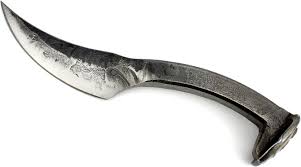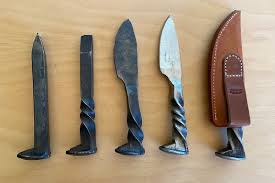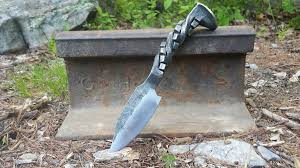Crafting a Railroad Spike Knife: Myths, Facts, and Techniques
The idea of transforming a railroad spike into a knife has captivated blacksmiths and knife enthusiasts for years. The rugged appearance and historical significance of railroad spikes make them an appealing material for custom knife-making. However, several myths surround the use of railroad spikes, particularly regarding their carbon content and suitability for knife-making. In this article, we’ll explore the reality behind these myths and offer insights into the process of creating a railroad spike knife.
The Myth of High Carbon Railroad Spikes

One of the most persistent myths in the knife-making community is that railroad spikes labeled “HC” are made from high-carbon steel. The truth is, the “HC” marking on a railroad spike stands for “Higher Carbon,” not “High Carbon.” According to ASTM A65-07 standards, HC spikes contain at least 0.30% carbon, with an acceptable variance of 0.03%. This composition classifies them as medium-carbon steel, not high-carbon steel. In comparison, true high-carbon steels like 1075 contain between 0.70% and 0.80% carbon.
While HC railroad spikes are not high-carbon steel, they still offer enough carbon content to make a functional knife, albeit one that may not hold an edge as well as a blade made from higher carbon steels.
Types of Steel Used in Railroad Spikes

Railroad spikes are typically made from different types of steel, each chosen for specific properties:
- Carbon Steel: Most modern railroad tracks are made from hot-rolled steel with a grade of 1084 or higher. This steel usually contains 0.7% to 0.8% carbon and up to 1% manganese, making it a medium-carbon steel. This type of steel is strong enough to withstand the stresses of railway use and is relatively easy to work with when forging knives.
- Alloy Steel: In some cases, railroad spikes are made from alloy steel, which includes additional elements like chromium, vanadium, or titanium. These elements enhance the steel’s hardness and durability, making it suitable for heavy-duty applications, though they are less common in spikes compared to tracks.
The Knife-Making Process: Forging a Railroad Spike Knife

Creating a railroad spike knife is a rewarding process that requires basic blacksmithing skills. Here’s a step-by-step guide:
- Selecting the Spike: Start by choosing an HC (Higher Carbon) railroad spike. While the carbon content is not as high as dedicated blade steels, it is sufficient for a knife that will see moderate use.
- Heating and Forging: Heat the spike in a forge until it reaches a bright orange color (approximately 1,800°F). This makes the metal malleable enough to forge. Use a hammer to flatten and shape the spike into a blade, starting from the tip and working towards the handle.
- Forming the Blade: After flattening the spike, begin shaping the blade. This involves drawing out the metal to create a point and refining the edges. The thickness of the blade should be gradually reduced towards the cutting edge.
- Twisting the Handle (Optional): Many blacksmiths choose to leave the spike’s head intact as a handle. For a decorative touch, you can twist the handle using a pair of tongs while the spike is still hot. This gives the knife a unique, rustic appearance.
- Quenching and Tempering: Once the knife is shaped, it must be hardened. Heat the blade again to the same orange color, then quench it in oil or water to rapidly cool it down. This process hardens the steel. However, quenching can make the steel brittle, so the knife should be tempered by reheating it to a lower temperature (around 400°F) and allowing it to cool slowly. This reduces brittleness while maintaining hardness.
- Sharpening and Finishing: Finally, grind the blade to achieve a sharp edge and polish the knife to the desired finish. You can also treat the handle to improve grip and appearance.
Conclusion: The Appeal of Railroad Spike Knives
While railroad spikes may not be high-carbon steel, they still provide a durable and aesthetically pleasing material for knife-making. The process of forging a knife from a railroad spike combines craftsmanship with historical charm, resulting in a functional tool that carries a story. Whether you’re a seasoned blacksmith or a hobbyist, creating a railroad spike knife is a project that connects you with the rich tradition of metalworking while producing a blade that’s both practical and unique.




